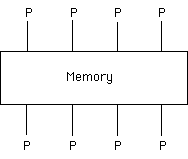

|
CS 334
|
SISD - traditional von Neumann - one processor, one piece of data at a time,
SIMD - currently used supercomputers (typically synchronous)
pipeline (interleave operations) for speed-up or
array-processor - do same thing to all elts of array,
MIMD - most interesting to computer science (asynchronous).

Difficulties - synchronization - wait for one to finish for another to take output and start.
Generalization of sequential algorithm not necessarily fastest on parallel machine
Contention over resources - reader - writer problem.

Each processor has its own memory but share a common communications channel.
In one of three states: executing, blocked, or waiting.
Problems:
With shared memory, communication typically via shared memory.
Problem: Mutual exclusion (reader-writer contention)
Distributed memory, communication via sending messages:
Problem: How to asynchronously send and receive messages?
Need mechanisms in OS to
Three major mechanisms:
Focus here on producer/consumer or bounded buffer problem.
Two processes cooperating, one by adding items to a buffer, the other
removing items. Ensure not remove when nothing there and not overflow
buffer as well.
Text also focuses on parallel matrix multiplication (read on own).
Text also discusses some ways of handling with simple extensions of existing languages:
Coroutines also worth noting (part of Modula-2). Iterators were a special case.
Idea is co-equal routines which pass control back and forth.
E.g., our Modula-2 has library supporting routines:
NewCoroutine(P: PROC; workspaceSize:CARDINAL; VAR q: COROUTINE);
Starts up new coroutine, q, by executing procedure P.
Transfer(VAR from, to: COROUTINE)
Transfers control from one coroutine to another.
Can have multiple coroutines executing same procedure or can all be distinct.
Usually run on single processor.
Can think of as supporting multi-tasking. Good for writing operating systems.
See Modula-2 code in text for bounded buffer problem with coroutines.
Three operations:
InitSem(S: Semaphore; value: integer);
Wait(S: Semaphore);
Signal(S: Semaphore);
InitSem starts up semaphore with an initial (non-negative) value.
Wait(S): If S > 0 then S := S - 1 else suspend self
Signal(S): if processes are waiting, then wake up a process, else S := S + 1;
Think of Wait(S) as claiming a resource so that no one else can get it, while Signal(S) releases the resource.
In order to solve mutual exclusion problem, must ensure that Wait and Signal execute atomically (i.e., cannot be interrupted and no one else can execute at same time).
If start w/S = 1 then protect a critical region by:
Wait(S); -- grab token
{Critical region}
Signal(S); -- release token
Can also start with other values of S, e.g., if start w/S = 0 and call
Wait(S) then suspend execution until another process executes Signal(S).
Solution to bounded buffer:
Suppose also have procedures:
CreateProcess(p:PROC; workspacesize: CARDINAL);
Creates nameless process
StartProcesses; -- starts all processes which have been created.
Terminate; -- stop execution of process
When all processes are terminated control returns to unit calling
StartProcesses.
Main program:
CreateProcess(Producer,WorkSize); - - create at least one producer
CreateProcess(Consumer,WorkSize); -- create at least one consumer
BufferStart := 1; BufferEnd := 0
InitSem(NonEmpty, 0) -- semaphore w/initial value of 0 to indicate empty
InitSem(NonFull, MaxBuffSize) -- semaphore w/initial value of size of buffer
InitSem(MutEx,1) -- semaphore used for mutual exclusion
StartProcesses
end;
Procedure Producer;
begin
loop
read(ch)
Wait(NonFull);
Wait(MutEx);
BufferEnd := BufferEnd MOD MaxBuffSize + 1;
Buffer[BufferEnd] := ch;
Signal(MutEx);
Signal(NonEmpty);
end loop;
end;
Procedure Consumer;
begin
loop
Wait(NonEmpty);
Wait(MutEx);
ch := Buffer[BufferStart];
BufferStart := BufferStart MOD MaxBuffSize + 1;
Signal(MutEx);
Signal(NonFull);
Write(ch)
end loop
end;
Why is there a MutEx semaphore?
Technically it is not necessary here since Producer only changes BufferEnd, while Consumer only changes BufferStart, but if they both changed a count of the number of items in the buffer would be important to keep them from executing at the same time!
What would go wrong if you changed the order of the two Wait's at the beginning of either Producer or Consumer?
Biggest problem with semaphores is that they are too low level and unstructured. Accidentally reversing order or Wait'ing twice could be disastrous.
The idea is to provide an ADT with "condition variables", each of which has an associated queue of processes and suspend (or delay) and continue ops for en and dequeuing processes. Suspend always stops current, continue starts up new if any waiting.
Concurrent Pascal uses monitors. Java "synchronized" similar.
type buffer = monitor;
var store: array[1..MaxBuffSize] of char;
BufferStart, BufferEnd, BufferSize: integer
nonfull, nonempty: queue;
procedure entry insert(ch: char);
begin
if BufferSize = MaxBuffSize then delay(nonfull);
BufferEnd :=BufferEnd mod MaxBuffSize + 1;
store[BufferEnd] := ch;
BufferSize := BufferSize + 1;
continue(nonempty)
end;
procedure entry delete(var ch: char);
begin
if BufferSize = 0 then delay(nonempty);
ch := store[BufferStart];
BufferStart := BufferStart mod MaxBuffSize + 1;
BufferSize := BufferSize -1;
continue(nonfull);
end;
begin (* initialization *)
BufferEnd := 0;
BufferStart := 1;
BufferSize := 0
end;
type producer = process (b: buffer);
var ch: char;
begin
while true do begin
read(ch);
b.insert(ch)
end;
end
type consumer = process(b: buffer);
var ch: char;
begin
while true do begin
b.delete(ch);
write(ch)
end
end;
var p: producer; q: consumer; b:buffer; begin init b, p(b), q(b) end.
Notice improved structure!
See text for simple way of emulating Semaphores w/ Monitors.